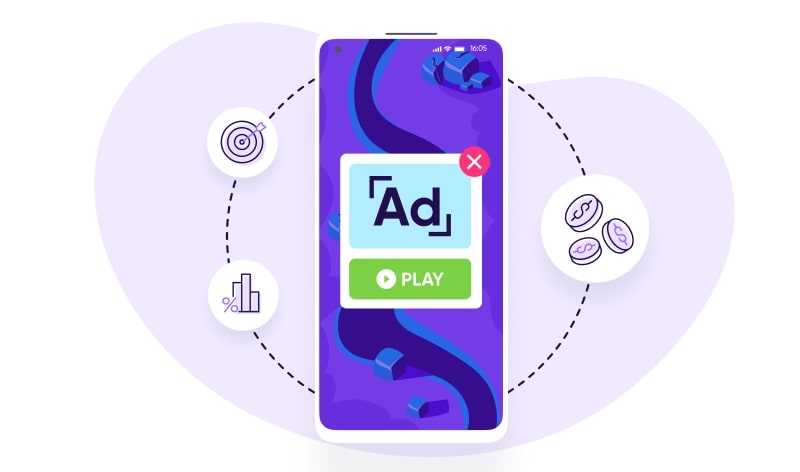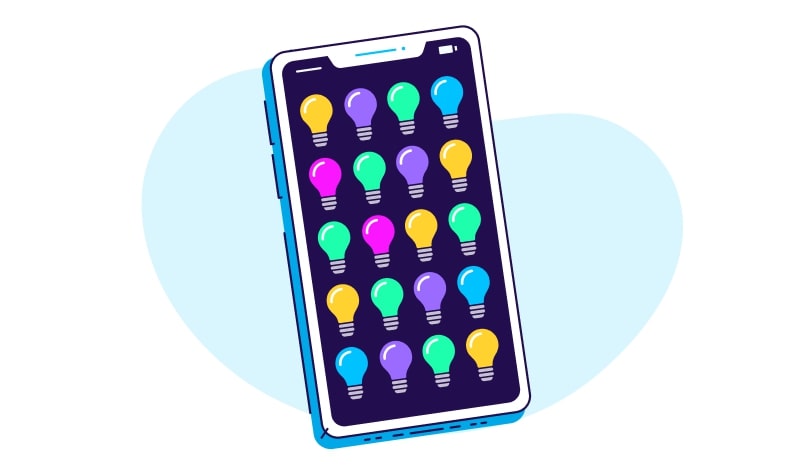Consumers spend upward of three hours a day on mobile devices, but at the same time are increasingly protective of their privacy, and are growing more and more wary of intrusive advertising that disrupts their experience.
Brand marketers want to reach consumers where they are, but the rise of data protection legislation means that marketers have to get creative to earn the user’s attention. And what’s more attention-grabbing than a game?
Playable ads are considered to be the most popular mobile ad format, and also the most engaging. They combine interactivity with gamification in an opt-in format and are a must-have in the marketer’s toolkit.
This post will provide you with the top-line insights you need to add playables to your digital marketing plans for 2021 and beyond.
What are they?
Playable ads use interactivity to mimic the gameplay or in-app experience.
They are sold as single premium ad units designed to capture consumer attention and generate high-converting leads. Playables create an immediate value exchange between the consumer and advertiser that drives engagement, and builds trust through an opted-in experience.
User choice is a key aspect of a playable’s appeal. The user gets a taste of the app before they commit to installation, and playing a mini-game is arguably a better way to pass a micro-moment than passively waiting for the ad to expire.
A relatively low-stakes interaction for the user has the potential to convert into high-value user acquisition for the brand.
Playable ads most commonly appear as in-app full-screen interstitials within leading social platforms, mobile gaming apps, as well as entertainment or media apps/sites.
Initially a “try before you buy” strategy for game developers, playables now extend to all types of brand experiences.
For its 2019 launch of an updated edition of its Fresh Foam sneakers, New Balance partnered with ad platform TreSensa to develop the in-app playable Cloud Jumper.
In the ad, users bounced animated bunnies on New Balance-branded trampolines, clouds, and pillows designed to illustrate the soft and lightweight shoe’s key attributes.
TreSensa reported that 20% of global customers who were served the ad engaged with it, and users spent an average of 22 seconds playing the game. “For a very hyper-casual game mechanic like this, where a user could actually play two to three times within that timeframe — because it’s hard and you lose pretty quickly — those results are really good,” said TreSensa co-founder and CEO Rob Grossberg.
Why should you use playable ads?

Because they’re valuable to both marketers and publishers who have had to rethink their strategies for advertising campaigns, due to ad-blocking technologies and restrictions on data tracking.
But playables offer much more than just a legal workaround.
One important advantage of playables is that the in-ad interaction points can be individually analyzed for performance and behavioral data. This, in turn, enables advertisers to optimize each creative element for even more effective targeting – without relying on traditional tracking measures for valuable first-party data.
What’s more, those who choose to interact with playables spend more time engaged and are more likely to move beyond awareness and consideration.
Burger King was one of the first non-gaming companies to experiment with playables with 2015’s Angriest Whopper game, which generated 336,700 plays and an average click-through rate of 40.25% in just 14 days, all for the reward of a Burger King coupon.
This top-of-funnel engagement drives down-funnel conversions and increases a customer’s lifetime value. Though the initial investment may be higher than regular videos or images, playables are more profitable in the long run.
Still need more convincing?
Here are a few more reasons why you should be using playable ads as part of your digital marketing plan:
- Playables help filter out non-committed users. We can’t stress enough how much an active opt-in measurably boosts conversion and retention rates, reduces uninstalls, and delivers a higher eCPM to ad publishers.
- Playables don’t require a download to engage, providing a frictionless experience that keeps users in a state of flow of their activities.
- Playables bring a moment of delight to users. Especially on mobile devices, users are either focused on a single task or looking for a delightful distraction to kill some time. Short gameplay perfectly combines these two states of attention.
- Playables are lightweight and load quickly, minimizing disruption to the customer experience.
- Playables can include more rich content elements such as video trailers, couponing, sweepstakes, ticketing, and more. This presents opportunities to offer more messaging and invitations for deeper interaction.
How to create a successful playable ad
This needs to consider four key aspects, each with their specific variables that contribute to the success of a playable:
- Creative elements
- Technical execution
- Ad placement and optimization
- Performance measurement.
Designing attention-grabbing creatives

Playable creatives can be broken into three key components, each of which deserves individual attention:
- Your prompt and/or tutorial is the critical “hook” for making a great first impression. Keep it snappy and demo only the most attractive and essential aspects of your game, and don’t forget to use familiar game mechanics so users can jump right in and play.
- The core play experience needs to be simple but dazzling. Use all of the creative resources you have available to create richness: music, animations, visual effects. Embed messaging that reinforces and drives toward a clear call to action (CTA).
- Your end card needs to offer a specific and actionable next step. Each playable should be laser-focused on a singular goal — a download, a sign-up, a click-through — and every interaction and message needs to get users there.
Developing according to technical standards
As we’ve already mentioned, playables have the advantage of being lightweight, meaning they load immediately. And the flexibility of HTML5 creates seamless experiences across mobile and desktop platforms.
Here are a few technical terms you’ll want to understand on a basic level when working with playable ad developers:
- Mobile Rich Media Ad Interface Definitions (MRAID) are “the common API (Application Programming Interface) for mobile rich media ads that will run in mobile apps.”
Developed by the Interactive Advertising Bureau (IAB), MRAID helps to standardize the display requirements across different ad publishing apps and platforms, saving time and money otherwise spent on the need to develop multiple rich media assets.
- The Open Measurement Software Development Kit (OM SDK) – an industry-wide effort to facilitate third-party ad verification and viewability measurement without requiring multiple SDKs from different service providers.
This allows all measurement partners in the ad ecosystem to tap into an ad’s viewability data from a single location on iOS and Android devices, giving marketers clearer insights into their campaign impressions and reducing reporting inconsistencies.
Optimize through testing and iteration
Each of the three main creative elements in a playable ad is trackable. Therefore, it can provide valuable measures of user engagement through their interactive behaviors: swiping, clicking, and tapping.

Analyzing this interaction data can help fine-tune the creative at a granular level, like making adjustments to character features or tweaking the game’s level of difficulty.
You might also consider A/B testing different variations of your end screen – relative to whether a user wins or loses a round – to see which CTAs are most effective at driving user engagement.
Optimization can, however, start with your ad’s placement. Given playables’ premium nature, two options stand out:
- Playables are often sold directly into the major social media and entertainment platforms. This creates “brand safety” by limiting the possibility an ad will be served up alongside something distracting or contradictory, and it keeps the user immersed in your brand experience.
- Placements bought through programmatic automations offer the opportunity for real-time campaign optimization, whether through dynamic bidding strategies to reach target audiences or swapping in dynamic creative to test different interaction patterns.
Measuring behavior at key interaction touchpoints
In addition to standard ad metrics, including CPM, CTR, ROAS (return on ad spend), each of the playables’ creative elements can provide engagement and time spent metrics. A few illustrative examples:
- The tutorial/opening card can provide data on upfront click-to-play/start, plus impressions and viewing times.
- The interactive/gameplay experience can provide engagement data on time spent, CTAs, and click-throughs.
- The end card can provide data on replay or share rates.
Best practices for playable ads
Game developers were early adopters of the playable format when it was introduced in 2014. Since then, best practices have emerged, as a diverse array of industries have adopted these interactive media nuggets.
Ultimately, playables are a customer-first medium, so accepted best practices are all about being attuned to what motivates your target audience and paying keen attention to user experience (UX).
- Focus on a key theme and a singular, persistent CTA with a clear and measurable campaign objective in mind.
- Create an intuitive, recognizable experience. Consumers should immediately understand how to interact with the ad.
- Keep the experience brief; typically, 15 seconds to one minute, maximum.
- Include your most essential and unique features to make it memorable.
- Reward consumers for their engagement to give them an incentive to convert.
Key takeaways
- Customers value organic and creative brand experiences but do not like to feel taken advantage of.
- Playables offer marketers an opportunity to drive growth and connect with audiences such as digitally native Gen Zers, which tend to ignore traditional marketing but respond well to mobile-first interactivity and gamification.
- Users are drawn to a playable’s immersive nature, but unlike other formats, they are given a choice about whether or not to engage.
- As important changes reshape the advertising industry, shifting more control into the hands of the customer, the power of playables is in its opt-in value exchange.
- When marketers give users more agency over their data, they create more authentic and mutually beneficial relationships between brands and customers.
The post It’s time to play – What marketers need to know about playable ads in 2021 appeared first on AppsFlyer.